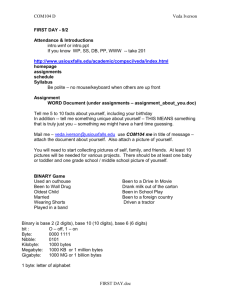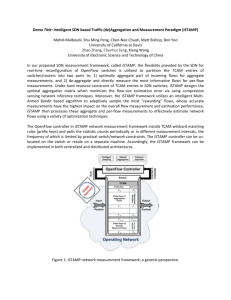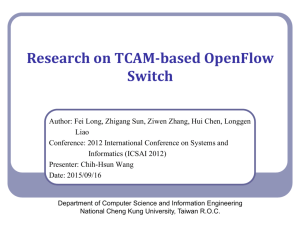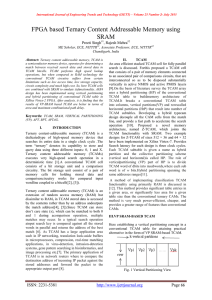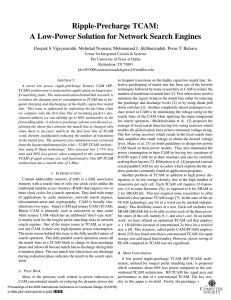Deduplication - DEEPNESS Lab
advertisement
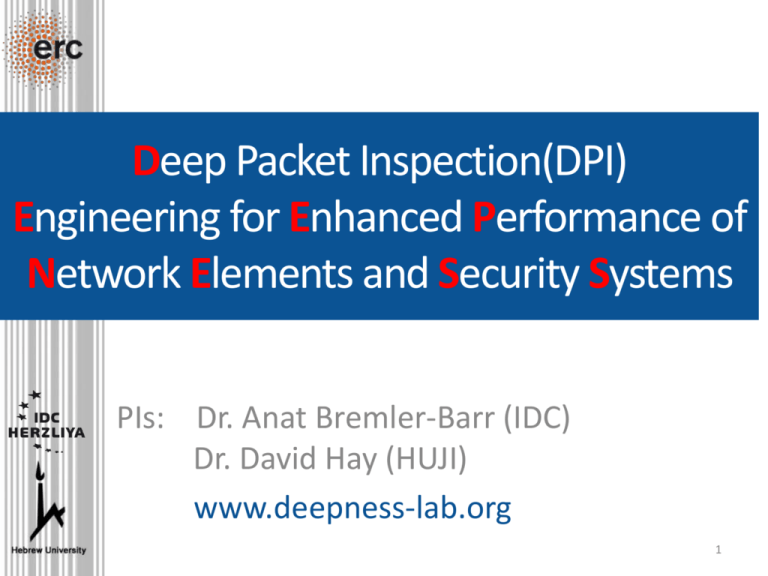
Deep Packet Inspection(DPI) Engineering for Enhanced Performance of Network Elements and Security Systems PIs: Dr. Anat Bremler-Barr (IDC) Dr. David Hay (HUJI) www.deepness-lab.org 1 • Deepness Lab was founded in November 2010 • Our mission: Deep Packet Inspection (DPI) for Next Generation Network devices • Funding: • 5 years ERC Starting Grant (1M Euro) • 3 years Kabarnit, a Magnet program ($70K/year) • A gift from Cisco ($75K) • Main Industry Collaborations: Commtouch, Radware, Verint 2 People Faculty: Anat Bremler-Barr (IDC Herzliya), David Hay(The Hebrew University of Jerusalem) Postdoc : Shimrit Tzur-David, Yaron Koral Ph.D. Students Liron Schiff (Tel Aviv University), Yotam Harchol (The Hebrew University of Jerusalem) Collaborators: Yehuda Afek (Tel Aviv University), Isaac Keslassy (Technion),Shir Landau-Feibish (Tel Aviv University) Past Students Victor Zigdon, M.Sc. (IDC Herzliya),Adam Mor, M.Sc. (IDC Herzliya) 3 People Dr. Anat Bremler-Barr - Ph.D. with distinction, TelAviv University, Israel (2001). Founder and chief scientist of Riverhead Networks (focused on distributed denial of service solution, and was acquired by Cisco). Senior lecturer (assistant professor) with tenure at IDC. Dr. David Hay - Ph.D. from the Technion (2007). Post-doc at Columbia University, NY, USA and Politecnico di Torino. Previously, also at IBM Research and Cisco San Jose. Senior lecturer (assistant professor) at the Hebrew U. Deep Packet Inspection (DPI) • DPI - Identifying signatures (patterns or regular expressions) in the packets’ payload • DPI is the main action taken to inspect traffic and therefore it is a critical component in next generation networks: security, content filtering, traffic monitoring, load balancing, lawful interception, targeted advertising, data leakage prevention, application-aware routing …. • High-speed DPI is challenging and quickly becomes the bottleneck of the entire packet inspection process. 5 Impact • 66% of network network equipment vendors define DPI as “a must have” technology today [Heavy Reading Survey, 2011] • DPI market on 2011 estimated at $550 million, growth of 20%/year [Qosmos report, Heavy Reading, Dec. 2012] 6 Major Challenges • Scalability: – Rate - greater than 10 or even 100 Gbps – Memory - handling thousands of signatures – Power - educing the high power consumption • Compressed traffic • Security of the NIDS itself: – Current solutions are vulnerable to Denial of Service attack • DPI in Software Defined Networks • Signatures Extraction 7 Compressed Traffic 14 Compressed HTTP • 84.1% of the top 1,000 sites compress their traffic. • Data compression is done by adding references to 19% increase repeated data. in 8 month! • There are two types of compression: – Intra-response compression – the references point to bytes within the response (Gzip/Deflate) – Inter-responses/connections compression – the references point to bytes in a separate file, called dictionary (Google’s SDCH). 15 Challenges Current security tools do not deal with compressed traffic due to the great challenges in time and space 16 Compressed Traffic : Space Challenge • Thousands of concurrent sessions Compressed, Mem: 32KB/session Uncompressed Traffic Contribution: Improve Space Time 80% 40% Compressed Traffic : Time Challenge • General belief: Decompression + pattern matching >> pattern matching • Our algorithms show how to accelerate the pattern matching using the compression information Decompression + pattern matching < pattern matching 18 High-Level Idea • Compression is done by compressing repeated sequences of bytes • Store information about the pattern matching results No need to fully perform again pattern matching on repeated sequences which were already scanned x2-3 time reduction • The buffers needed for decompression are not used most of the time, and therefore can be kept in compressed form most of time x5 space reduction 19 The Other Side of the Coin: Acceleration by Identifying repetitions in uncompressed Traffic There are repetitions in uncompressed HTTP traffic – Entire files (e.g., images) – Parts of the files (e.g., HTML tags, javascripts) We keep scanning again and again the same thing (and get the same scanning results..) 1. Identify frequently repeated data Stored in a dictionary 2. Perform DPI on the data once and remember the results DPI by pattern matching Aho-Corasick algorithm. Result is the state. 3. When encountering a repetition, recover the state without rescanning Delicate points need to be taken care of, so we won’t miss any pattern 23 Securing the NIDS Itself 24 Complexity DoS Attack Over NIDS • Easy to craft – very hard to process packets • 2 Steps attack: 1. Kill IPS/FW Attacker Internet 2. Sneak into the network Attack on Security Elements Combined Attack: DDoS on Security Element exposed the network – theft of customers’ information Attack on Snort The most widely deployed IDS/IPS worldwide. Heavy packets rate OUR GOAL: A multi-core system architecture, which is robust against complexity DDoS attacks System Throughput Over Time Reaction time can be smaller System Architecture Q Core #1 Q Core #2 Q Core #8 Q Core #9 Q Core #10 Routine Mode: Load balance between cores Processor Chip NIC Detects heavy packets System Architecture Q Core #1 Q Core #2 Q Core #8 Alert Mode: Dedicated cores for heavy packets Others detect and move heavy to Dedicated. Q Q Dedicated Core #9 Dedicated Core #10 Processor Chip NIC Detects heavy packets B B B Cloud solution • The different cores are different (virtual) machines. • Load balancing sends heavy packets to machines that run a special more efficient processing method. • In SDN, this can be done even faster and easier. 32 DPI using TCAMs 33 TCAM – Ternary Content- Addressable Memory 1 2 3 1110101010100101001********1111 1110101010100101001*******11111 1110101010100101001*********011 4 0011101010********************* 1110*********0101001010101010** 5 1110101010100101001************ 6 *************************001110 0011101010101****************** 7 8 9 0 0 0 1 0 2 1 0 0 1 Encoder 0 Action 3 3 4 5 6 7 1 0 De-facto solution 1111111111111111111111111111*** 1 *******************************classification. of packet 8 9 deny deny accept deny accept deny deny deny log accept Core component of SDN switch Match lines TCAM SRAM Search Key 0011101010101001110001110001110 34 Some Challenges In Using TCAM • Reducing the number of entries power consumption reduction • Dealing with ranges (how to encode the range [1-6]?) • How to correct errors? – More about it in the next slide • How to use it for non-traditional tasks – Traditionally, TCAM is used for IP lookup and header classification (e.g., using 5-tuples) 35 Example: Error Correction in TCAM • In SRAM (or any regular memory) – Input: address (entry number) – Output: content of that address – One can apply an error detection/correcting code on that content • In TCAM – Even if the content seems OK, we still have false miss or indirect false miss errors, TCAM EDC/ECC are harder PEDS: Parallel Error Detection Scheme for TCAM Devices • Detecting all errors using the built-in parallel lookup of the TCAM • The number of lookups is a function of the width of the TCAM word, and not the number of entries in the database. – Which is 3 orders of magnitude larger • Developed, patented in DEEPNESS lab CompactDFA for DPI • Using TCAM to represent a huge DFA in a compact manner. • Reducing the problem of pattern matching to IP lookup (much easier problem) • Each byte scan one TCAM lookup – Can be reduced using variable stride traversal – Further performance boost with parallelism and pipelining 38 TCAM Current Sym Next State 1 0000(s0) A 0000 (s0) 2 0000(s0) B 0110(s6) 3 0000(s0) C 1100(s12) 4 0000(s0) D 0000(s0) 5 0000(s0) E 0001(s1) 6 0000(s0) F 0000(s0) 7 0001(s1) A 0000(s0) 8 0001(s1) B 0010(s2) 9 0001(s1) C 0000(s0) 10 0001(s1) D 0000(s0) 11 0001(s1) E 0000(s0) 12 0001(s1) F 0000(s0) 13 0010(s2) A 0000(s0) 14 0010(s2) B 0100(s4) 15 0010(s2) C 0011(s3) 16 0010(s2) D 0000(s0) 84 1101(s13) F 0000 (s0) SRAM Longest Prefix Match DFA CompactDFA Snort: 73MB 0.6MB ClamAV: 1.5GB 26MB Signature Extraction 40 Current DDoS Attack • Armies of zombies Many sources • Hard to identify behaviorally • No known signatures Zombies on innocent computers Infrastructure-level DDoS attacks Bandwidth-level DDoS attacks Server-level DDoS attacks 41 Automated Extraction of Signatures for Zero-day Internet Attacks • Input: • sample of attack traffic (high volume attack) • sample of normal traffic Output: Automatically find signatures that appear frequently only during attack • Where: – Input collection: • In mitigation apparatus (DDoS Guard/firewall/anti-DDoS etc.) • In the cloud – collect data from several collectors. – DDoS – power computation saving – Signatures used by anti-DDoS devices and firewalls to stop attack • Mitigation in minutes, good enough for these types of attacks 42






